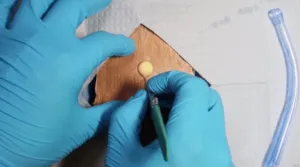An abscess is a confined collection of pus surrounded by inflamed tissue. Most abscesses are found on the extremities, buttocks, breast, axilla, groin, and areas prone to friction or minor trauma, but they may be found in any area of the body. Abscesses are formed when the skin is invaded by microorganisms. Cellulitis may precede or occur in conjunction with an abscess.
The two most common microorganisms leading to abscess formation are Staphylococcus and Streptococcus. Perianal abscesses are commonly caused by enteric organisms. Gram-negative organisms and anaerobic bacteria also contribute to abscess formation.
Treatment of an abscess
Treatment of an abscess is primarily through incision and drainage (I&D). Smaller abscesses (<5 mm) may resolve spontaneously with the application of warm compresses and antibiotic therapy. Larger abscesses will require I&D as a result of an increase in collection of pus, inflammation, and formation of the abscess cavity, which lessens the success of conservative measures.
Untreated abscesses may follow one of two courses. The abscess may remain deep and slowly reabsorb, or the overlying epithelium may attenuate (i.e., pointing), allowing the abscess to spontaneously rupture to the surface and drain. Rarely, deep extension into the subcutaneous tissue may be followed by sloughing and extensive scarring. Conservative therapy for small abscesses includes warm, wet compresses and anti-Staphylococcal antibiotics. I&D is a time-honored method of draining abscesses to relieve pain and speed healing.
After I&D, it is best to watch for signs of cellulitis or recollection of pus. Patients should change packing or arrange for the patient’s packing to be changed as necessary. Cellulitis occurs most commonly in patients with diabetes or other diseases that interfere with immune function.
Reasons for Procedure
Drainage of an abscess is the preferred treatment to clear an abscess. It is often used if the abscess is large, growing, painful, or not improving on its own.
Possible Complications
Problems are rare, but all procedures have some risk. The doctor will go over problems that could happen, such as:
- Bleeding
- Scarring
- Damage to nearby structures
Things that may raise the risk of problems are:
- Smoking
- Drinking alcohol
- Long term diseases such as diabetes or obesity
Call Your Doctor
Call your doctor if you are not getting better or have:
- Signs of infection, such as fever and chills
- Worsening pain, redness, swelling, and bleeding
- Changes in discharge such as pus



